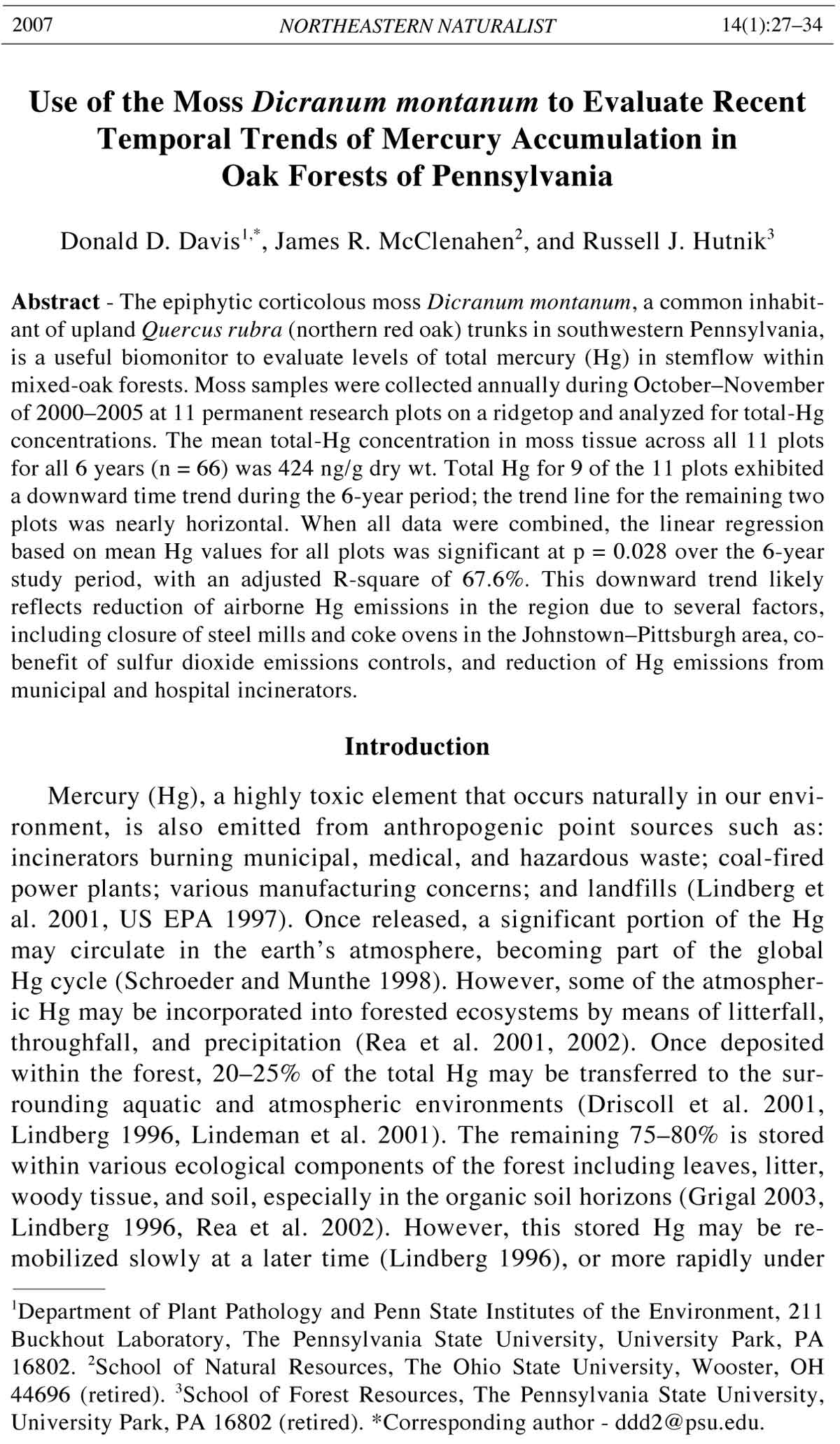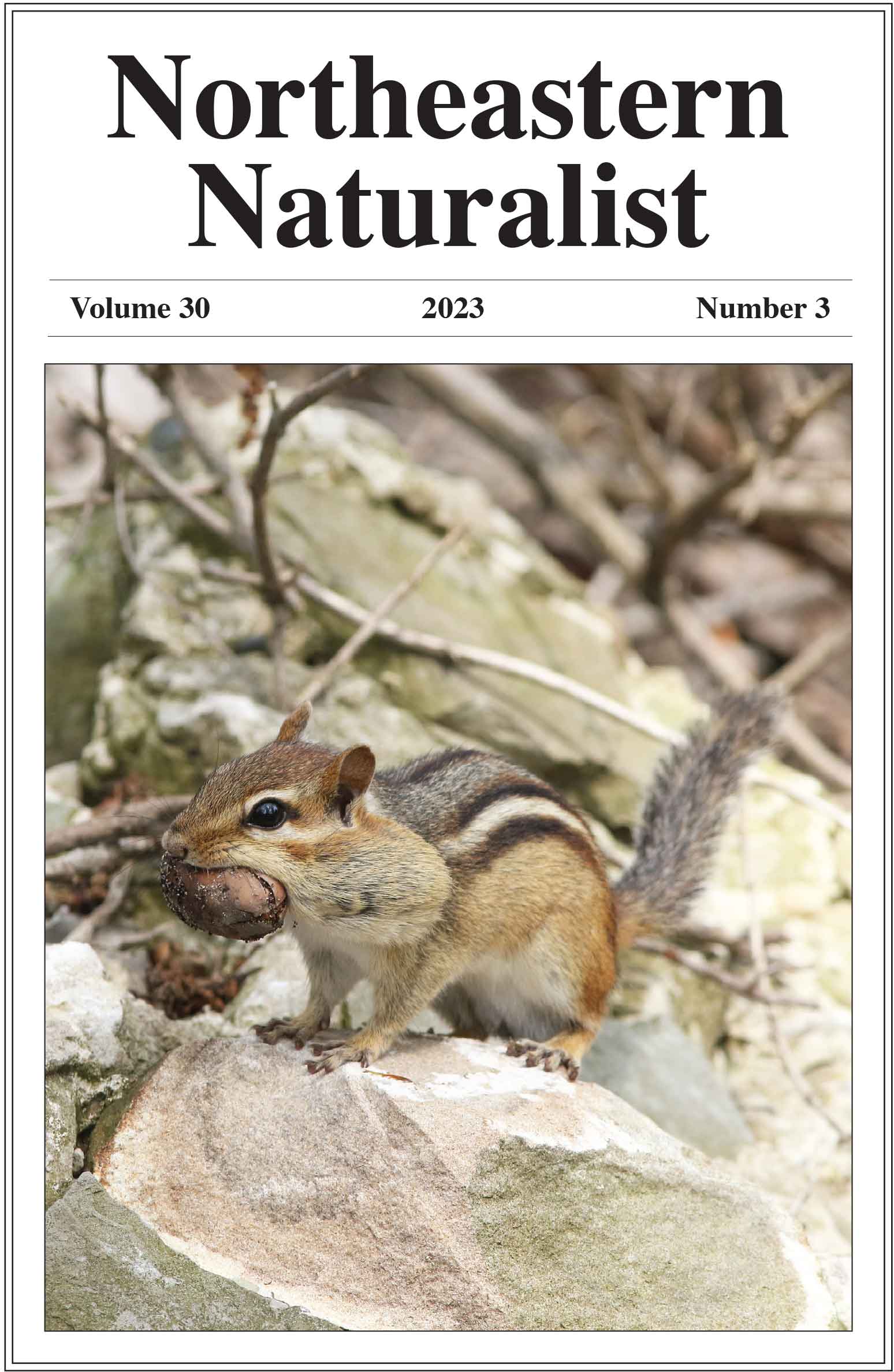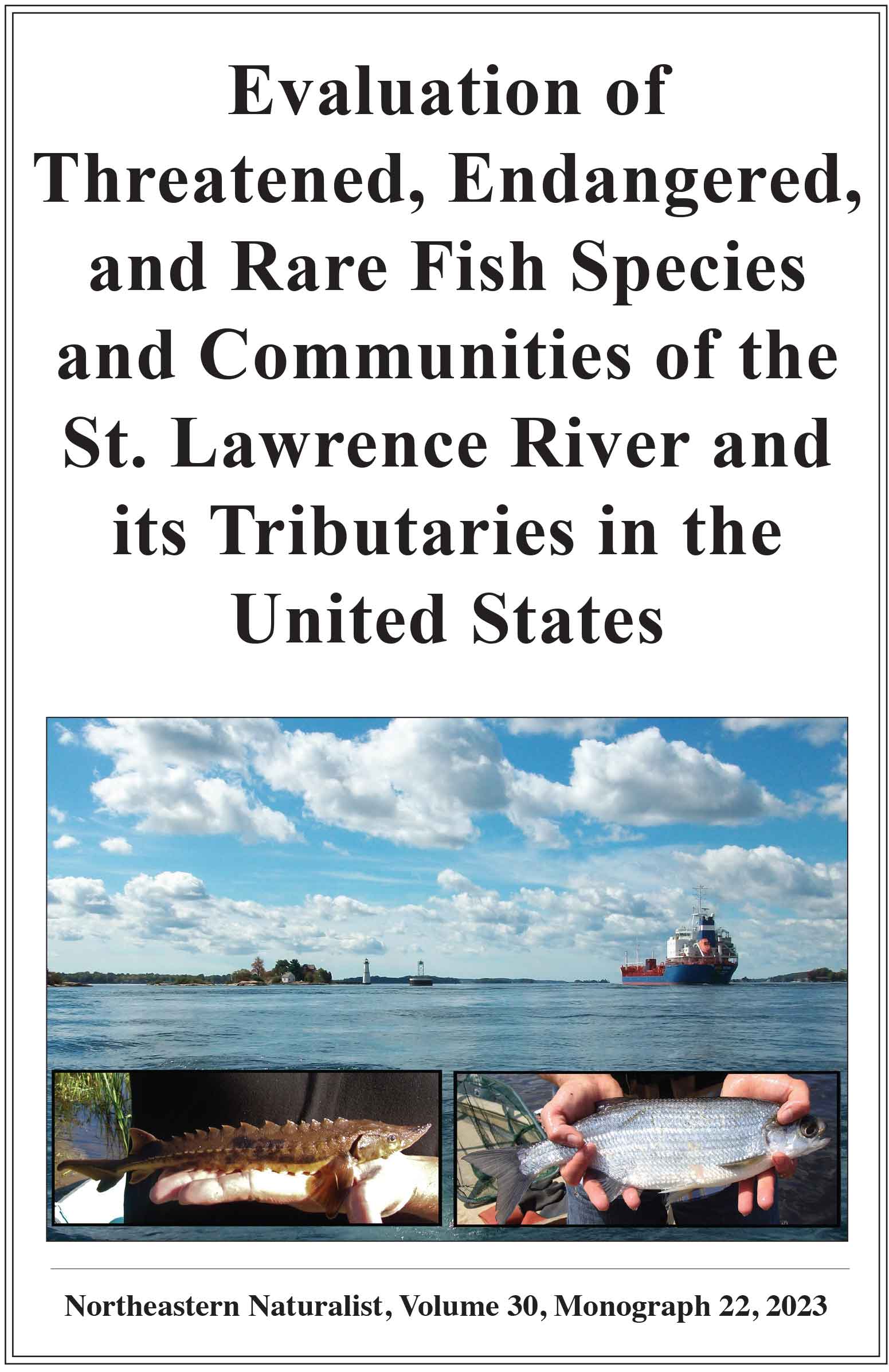Use of the Moss Dicranum montanum to Evaluate Recent Temporal Trends of Mercury Accumulation in Oak Forests of Pennsylvania
Donald D. Davis, James R. McClenahen, and Russell J. Hutnik
Northeastern Naturalist, Volume 14, Issue 1 (2007): 17–34
Full-text pdf (Accessible only to subscribers.To subscribe click here.)

Access Journal Content
Open access browsing of table of contents and abstract pages. Full text pdfs available for download for subscribers.
Current Issue: Vol. 30 (3)

Check out NENA's latest Monograph:
Monograph 22









2007 NORTHEASTERN NATURALIST 14(1):27–34
Use of the Moss Dicranum montanum to Evaluate Recent
Temporal Trends of Mercury Accumulation in
Oak Forests of Pennsylvania
Donald D. Davis1,*, James R. McClenahen2, and Russell J. Hutnik3
Abstract - The epiphytic corticolous moss Dicranum montanum, a common inhabitant
of upland Quercus rubra (northern red oak) trunks in southwestern Pennsylvania,
is a useful biomonitor to evaluate levels of total mercury (Hg) in stemflow within
mixed-oak forests. Moss samples were collected annually during October–November
of 2000–2005 at 11 permanent research plots on a ridgetop and analyzed for total-Hg
concentrations. The mean total-Hg concentration in moss tissue across all 11 plots
for all 6 years (n = 66) was 424 ng/g dry wt. Total Hg for 9 of the 11 plots exhibited
a downward time trend during the 6-year period; the trend line for the remaining two
plots was nearly horizontal. When all data were combined, the linear regression
based on mean Hg values for all plots was significant at p = 0.028 over the 6-year
study period, with an adjusted R-square of 67.6%. This downward trend likely
reflects reduction of airborne Hg emissions in the region due to several factors,
including closure of steel mills and coke ovens in the Johnstown–Pittsburgh area, cobenefit
of sulfur dioxide emissions controls, and reduction of Hg emissions from
municipal and hospital incinerators.
Introduction
Mercury (Hg), a highly toxic element that occurs naturally in our environment,
is also emitted from anthropogenic point sources such as:
incinerators burning municipal, medical, and hazardous waste; coal-fired
power plants; various manufacturing concerns; and landfills (Lindberg et
al. 2001, US EPA 1997). Once released, a significant portion of the Hg
may circulate in the earth’s atmosphere, becoming part of the global
Hg cycle (Schroeder and Munthe 1998). However, some of the atmospheric
Hg may be incorporated into forested ecosystems by means of litterfall,
throughfall, and precipitation (Rea et al. 2001, 2002). Once deposited
within the forest, 20–25% of the total Hg may be transferred to the surrounding
aquatic and atmospheric environments (Driscoll et al. 2001,
Lindberg 1996, Lindeman et al. 2001). The remaining 75–80% is stored
within various ecological components of the forest including leaves, litter,
woody tissue, and soil, especially in the organic soil horizons (Grigal 2003,
Lindberg 1996, Rea et al. 2002). However, this stored Hg may be remobilized
slowly at a later time (Lindberg 1996), or more rapidly under
1Department of Plant Pathology and Penn State Institutes of the Environment, 211
Buckhout Laboratory, The Pennsylvania State University, University Park, PA
16802. 2School of Natural Resources, The Ohio State University, Wooster, OH
44696 (retired). 3School of Forest Resources, The Pennsylvania State University,
University Park, PA 16802 (retired). *Corresponding author - ddd2@psu.edu.
28 Northeastern Naturalist Vol. 14, No. 1
drastic environmental conditions such as wildfires (Amirbaham et al.
2004) or deliberate burning (Mailman and Bodaly 2005).
Along with our colleagues, we have reported concentrations of trace
elements in tree leaves (Davis et al. 1995, Hutnik et al. 1989), soil and xylem
(Long and Davis 1989), and lichens (Showman and Long 1992) in Pennsylvania.
In 2001, we reported trace element concentrations (not including Hg)
within an epiphytic, corticolous moss (Dicranum montanum Hedw.) growing
on Quercus rubra L. (northern red oak) trunks within a study area in
upland mixed-oak forests of southwestern Pennsylvania (Davis et al. 2001).
In 2002, we reported the following approximate total Hg concentrations (ng/
g dry wt) in various components of the same forest ecosystem: leaves of
Prunus serotina Ehrh. (black cherry), Acer rubrum L. (red maple), and
northern red oak (60–70 ng/g); forest floor litter (100 ng/g); upper mineral
soil (130 ng/g); the lichen Punctelia subrudecta (Nyl.) Krog. (180 ng/g);
organic soil layer (430 ng/g); and the epiphytic corticolous moss D.
montanum (500 ng/g) (Davis et al. 2002).
In the latter two studies, we reported that D. montanum was a useful
biomonitor to evaluate levels of various trace elements, including total Hg,
within mixed-oak forests of southwestern Pennsylvania. Mosses have been
used for decades to evaluate deposition of airborne pollutants, including Hg
(see review in Tyler 1990). However, most of these studies have used, by
design, open-grown mosses rather than corticolous, epiphytic, tree-trunk
mosses. In our studies, we have used epiphytic mosses that sorb the chemically
enriched stemflow (Watters and Price 1988) washed down the trunks of
trees, which can be used to determine spatial and temporal trends in Hg
concentrations within forests.
Biomonitors such as corticolous mosses are simple to collect, widespread,
inexpensive, and may be used as surrogates for more expensive,
instrumental monitoring to evaluate Hg levels in forests. Mosses such as D.
montanum are likely independent of short-term Hg inputs and integrate
fluctuations in Hg concentrations and volumes. These mosses are biologically
important components of the forest ecosystem, and thus, their Hg
content has more direct ecological meaning than chemical or instrumental
Hg monitors.
The primary objective of this research was to determine temporal trends
in Hg concentrations during 2000–2005, as measured by total Hg levels
within the tissues of D. montanum, within upland mixed-oak forests of
southwestern Pennsylvania.
Methods
Study area
Our study area is located within mixed-oak forests along the top of
Laurel Ridge in southwestern Pennsylvania (Davis et al. 2001, 2002).
Second- and third-growth northern red oak forests dominate the ridgetop,
with a significant component of red maple, occasional black cherry trees,
2007 D.D. Davis, J.R. McClenahen, and R.J. Hutnik 29
and a few other hardwood species. The site index (height in m at age 50)
for northern red oak on ridgetops is approximately 18, and canopies are
generally closed except for occasional, scattered gaps created by oak mortality.
The understory is dominated by Dennstaedtia punctilobula (Michx.)
T. Moore (hay-scented fern). Soils are well- to moderately well-drained,
very stony loams and silt loams, predominantly Typic Dystrochrepts, and
occasionally some Typic Hapludults and Aquic Fragiudults (McClenahen
et al. 1999).
Laurel Ridge is the first major ridge east of the Rocky Mountains that
pollutant-laden air masses encounter as they travel eastward with prevailing
winds. The higher elevation of the ridge, relative to the valley floor, may
enhance regional deposition of chemical elements (Miller et al. 1993). The
ridgetop also likely intercepts long-range transport of regional pollutants
from the industrialized Ohio River Valley, located upwind and to the west of
the study area (Pierson et al. 1989), and may receive varying amounts of
pollution from nearby industrialized/urban areas (Davis et al. 2001). The
ridgetop terrain is favorable for early morning inversions that trap pollutants
(Hutnik et al. 1989). In addition, the ridgetop is subject to frequent fog and
low clouds, a condition that may also increase pollutant deposition from
long-distance and regional sources (Lovett 1984). The area encompassing
the study plots receives an annual wet deposition of 9–11 g/m2 total Hg
(Lynch et al. 2001).
Data collection and analyses
In 1996, we established 11 permanent forested study plots at ca. 5-km
intervals along the ridgetop (Davis et al. 2001). During October–November
of 2000–2005, we collected moss samples for Hg analysis from each plot, as
described by Davis et al. (2001), from the trunks of six individual red oak
trees on or near each permanent plot. The six samples were combined into
one sample/plot for each of 6 years (n = 66). Unwashed moss samples were
placed in labeled paper bags, air-dried, and passed through a 2-mm mesh
sieve. Sieved samples were mailed to Flett Research Ltd. (Winnipeg,
Manitoba, Canada) where they were analyzed for total Hg using cold-vapor
atomic fluorescence spectrometry. Appropriate standards, blanks, and quality
control/quality assurance procedures were used throughout the analyses.
Temporal trends in total Hg concentrations within moss tissues were evaluated
using regression techniques (Minitab 2003).
Results and Discussion
Hg concentrations
The mean total-Hg concentration across all plots and across all 6 years
was 424 ng/g dry wt. This overall average is less than the mean of 500 ng/g
total Hg previously reported for 70 D. montanum samples taken from the
same 11 plots in the year 1999 (Davis et al. 2002). However, the 1999
samples were analyzed using a less-sensitive method (inductively coupled
30 Northeastern Naturalist Vol. 14, No. 1
plasma-mass spectrometry), which has since been discontinued in favor of
the more sensitive (lower level of detection) cold-vapor atomic fluorescence
spectrometry. Nevertheless, both studies support our conclusion that the
epiphytic, corticolous moss D. montanum sorbs significant levels of total Hg
within this mixed-oak forest ecosystem. The Hg levels in D. montanum were
greater than those in other components of a forest ecosystem, including tree
leaves, lichens, litter, mineral soil, and open-grown mosses (Davis et al.
2002, Lindberg 1996, Rea et al. 2002, Tyler 1990). Only the total-Hg content
of the humus layer of the soil at these sites approached the level of Hg in
moss (Davis et al. 2002). It is likely that the total-Hg concentrations in D.
montanum were reflective of the highly chemically enriched stemflow
(Watters and Price 1988) containing entrapped particulate matter (Bargagli
1998), and/or that this moss species is an accumulator of Hg.
Mosses have been widely used in Europe for years to examine spatial and
temporal trends in trace element deposition (see Bargagli 1998, Berg and
Steinnes 1997). However, European researchers generally have used opengrown
moss species, rather than moss growing under a forest canopy, since
their main objective was usually to evaluate widespread geographic patterns
not influenced by the differences among regional forest canopies (Steinnes
et al. 1992, 1994). In contrast, we selected an epiphytic, corticolous moss
species that grows on the moist sides of tree trunks where it sorbs stemflow.
Stemflow contains materials deposited onto the canopy by dry deposition
that are later washed down the trunk as stemflow by wet deposition.
Stemflow also contains pollutants inherent within the wet deposition. Thus,
a corticolous moss reflects the chemically enriched stemflow, which in turn
reflects both dry and wet deposition. Stemflow can thus be used to evaluate
patterns in trace-element concentrations, as opposed to using throughfall or
incident precipitation (Rea et al. 2001).
Our data also reflect the extent of enrichment of Hg input within the
forest ecosystem. We have determined that the tissues of log mosses (i.e.,
Hypnum spp.), growing immediately adjacent to D. montanum on red oak
trunks, have much lower concentrations of trace elements than D.
montanum. The log mosses likely sorb most of their trace elements from
throughfall, as opposed to the chemically-enriched stemflow sorbed by
epiphytic corticolous mosses. In addition, log mosses may not be accumulators
of total Hg.
We have also observed that the large pads of D. montanum remain wet
for some time after prolonged periods of rainfall. Therefore, we speculated
that some of the inorganic, entrapped Hg in the moss tissues might be
transformed to methylmercury (MeHg) by microbial methylation under
anaerobic conditions (Hall and St. Louis 2004, Mailman and Bodaly 2005).
MeHg is a potent neurotoxin that may be biomagnified in the food chain
(Ullrich et al. 2001). To determine the magnitude of MeHg in D. montanum,
we collected five additional moss samples from each of two plots in 2003.
For the first plot, the MeHg concentration in the moss tissue averaged 3.01
2007 D.D. Davis, J.R. McClenahen, and R.J. Hutnik 31
ng/g, as compared to the total Hg average of 421 ng/g at that plot. For the
second plot, the average MeHg concentration was 2.83 ng/g, compared to
total Hg of 353 ng/g at that location. These MeHg concentrations represented
approximately 0.71% and 0.80% of the total Hg concentrations
within the moss at the two plots, respectively. These results are in general
agreement with Grigal (2003), who reported that the average ratio of MeHg
to total Hg in plant material was nearly identical to that of open precipitation
(approximately 1%).
Trends over time
Total-Hg levels in D. montanum, averaged across all 11 plots, declined
from 2000 to 2005 (Fig. 1). When all data were combined, the linear regression
based on mean Hg values was significant at p = 0.028 with an adjusted Rsquare
of 67.6%. Inclusion of the 1999 value increased the R-square to 78.5%
and p = 0.006. This downward trend likely reflects regional reduction of
airborne Hg emissions due to several factors, including closure of steel mills
and coke ovens in the Johnstown–Pittsburgh area, co-benefit of sulfur dioxide
emission controls, and reduction of Hg emissions from municipal and hospital
incinerators. We plan to annually monitor Hg levels in this moss species in
future years to determine if the downward temporal trend continues.
Figure 1. Linear regression illustrating the downward trend in average Hg levels
within Dicranum montanum tissues (ng/g dry wt) during 2000–2005. Analysis based
on annual means of plots per year for 6 years (adjusted R2 = 67.6%, p = 0.028).
32 Northeastern Naturalist Vol. 14, No. 1
Acknowledgments
This study was funded by the Keystone-Conemaugh Owners Group, Indiana, PA.
The authors wish to thank bryologist Dr. Ronald A. Pursell, Professor Emeritus, The
Pennsylvania State University, for initial identification of Dicranum montanum.
Literature Cited
Amirbaham, A., P.L. Ruck, I.J. Fernandez, T.A. Haines, and J.S. Kahl. 2004. The
effect of fire on mercury cycling in the soils of forested watersheds: Acadia
National Park, USA. Water, Air, and Soil Pollution 152:313–331.
Bargagli, R. 1998. Trace Elements in Terrestrial Plants: An Ecophysiological
Approach to Biomonitoring and Biorecovery. Springer-Verlag, New York,
NY. 324 pp.
Berg, T., and E. Steinnes. 1997. Use of mosses (Hylocomium splendens and
Pleurozium schreberi) as biomonitors of heavy metal deposition: From relative
to absolute deposition values. Environmental Pollution 98:61–71.
Davis, D.D., J.M. Skelly, and B.L. Nash. 1995. Major and trace element concentrations
in red oak, white oak, and red maple foliage across an atmospheric deposition
gradient in Pennsylvania. USDA Forest Service, Northeastern Forest Experiment
Station, Morgantown, WV. General Technical Report NE-197:188–195.
Davis, D.D., J.R. McClenahen, and R.J. Hutnik. 2001. Deposition of air pollutants in
southwestern Pennsylvania as measured by an epiphytic moss (Dicranum
montanum) on northern red oak. Northeastern Naturalist 8:379–392.
Davis, D.D., J.R. McClenahen, and R.J. Hutnik. 2002. Selection of a biomonitor to
evaluate mercury levels in forests of Pennsylvania. Northeastern Naturalist
9:183–192.
Driscoll, C.T., M. Kalicin, M. Lindeman, C. Liuzzi, R. Newton, R. Munson, and J.
Yavitt. 2001. Chemical and biological control of mercury cycling in upland,
wetland, and lake ecosystems in the northeastern US. P. 29, In Workshop on the
Fate, Transport, and Transformation of Mercury in Aquatic and Terrestrial Environments,
West Palm Beach, FL. 109 pp.
Grigal, D.F. 2003. Mercury sequestration in forests and peatlands: A review. Journal
of Environmental Quality 32:393–405.
Hall, B.D., and V.L. St. Louis. 2004. Methylmercury and total mercury in plant litter
decomposing in upland forests and flooded landscapes. Environmental Science
and Technology 38:5010–5021.
Hutnik, R.J., D.D. Davis, and J.R. McClenahen. 1989. Evaluation of vegetation near
coal-burning power plants in southwestern Pennsylvania. I. Sulfur content of
foliage. Journal Air Pollution Control Association 39:1440–1443.
Lindberg, S.E. 1996. Forests and the global biogeochemical cycle of mercury: The
importance of understanding air/vegetation exchange processes. Pp. 359–380, In
W. Baeyens, R. Ebinghaus, and O. Vasiliev (Eds.). Global and Regional Mercury
Cycles: Sources, Fluxes, and Mass Balances. NATO-ASI-Series, Vol. 21,
Kluwer Academic Publishers, Dordrecht, The Netherlands.
Lindberg, S.E., H. Zhang, G. Southworth, D. Reinhart, P. McCreanor, D.
Wallschlager, and J. Price. 2001. Atmospheric mercury emissions from municipal
solid waste landfills. P. 90, In Workshop on the Fate, Transport, and
2007 D.D. Davis, J.R. McClenahen, and R.J. Hutnik 33
Transformation of Mercury in Aquatic and Terrestrial Environments, West
Palm Beach, FL, 109 pp.
Lindeman, M.A., M. Kalicin, C.T. Driscoll, C. Liuzzi, R. Newton, R. Munson, W.
Krester, and J. Yavitt. 2001. The fate and cycling of mercury in the Sunday Lake
watershed, Adirondacks, New York: A preliminary mass balance. P. 90, In
Workshop on the Fate, Transport, and Transformation of Mercury in Aquatic and
Terrestrial Environments, West Palm Beach, FL. 109 pp.
Long, R.P., and D.D. Davis. 1989. Major and trace element concentrations in surface
organic layers, mineral soil, and white oak xylem downwind from a coal-fired
power plant. Canadian Journal Forest Research 19:1603–1615.
Lovett, G.M. 1984. Rates and mechanisms of cloud water deposition to a subalpine
balsam fir forest. Atmospheric Environment 18:361–371.
Lynch, J.A., K.S. Horner, and J.W. Grimm. 2001. Mercury deposition in Pennsylvania:
Status report. The Pennsylvania State University, Environmental Resources
Research Institute, University Park, PA. Report ER2001-1, 52 pp.
Mailman, M., and R.A. Bodaly. 2005. Total mercury, methyl mercury, and carbon in
fresh and burned plants and soil in northwestern Ontario. Environmental Pollution
138:161–166.
McClenahen, J.R., D.D. Davis, and R.J. Hutnik. 1999. Northern red oak growth
response to climate and industrial air pollution in western Pennsylvania. USDA
Forest Service, Southern Forest Experiment Station, Asheville, NC. General
Technical Report SRS-24: 245–251.
Miller, E.K., A.J. Friedland, E.A. Arons, V.A Mohnen, J.J. Battles, J.A. Panek, J.
Kadlecek, and A.H. Johnson. 1993. Atmospheric deposition to forests along an
elevational gradient at Whiteface Mountain, NY, USA. Atmospheric Environment
27a:2121–2136.
Minitab. 2003. Minitab Inc., Quality Plaza, 1829 Pine Hall Road, State College,
PA 16801.
Pierson, W.R., W.W. Brachaczek, R.A. Gorse, S.M. Japar, and J.M. Norbeck. 1989.
Atmospheric acidity measurements on Allegheny Mountain and the origins of
ambient acidity in the northeastern United States. Atmospheric Environment
23:431–459.
Rea, A.W., S.E. Lindberg, and G.J. Keeler. 2001. Dry deposition and foliar leaching
of mercury and selected trace elements in deciduous forest throughfall. Atmospheric
Environment 35:3453–3462.
Rea, A.W., S.E. Lindberg, T. Scherbatskoy, and G.J. Keeler. 2002. Mercury accumulation
in foliage over time in two northern mixed-hardwood forests. Water, Air
,and Soil Pollution 133:49–67.
Schroeder, W.H., and J. Munthe. 1998. Atmospheric mercury: An overview. Atmospheric
Environment 32:809–822.
Showman, R.E., and R.P. Long. 1992. Lichen studies along a wet sulfate deposition
gradient in Pennsylvania. The Bryologist 95:166–170.
Steinnes, E., J.P. Rambaek, and J.E. Hanssen. 1992. Large scale multi-element
survey of atmospheric deposition using naturally growing moss as bioindicators.
Chemosphere 25:735–752.
Steinnes, E., J.E. Hanssen, J.P. Rambaek, and N.B. Vogt. 1994. Atmospheric deposition
of trace elements in Norway: Temporal and spatial trends studied by moss
analysis. Water, Air, and Soil Pollution 74:121–140.
34 Northeastern Naturalist Vol. 14, No. 1
Tyler, G. 1990. Bryophytes and heavy metals: A literature review. Botanical Journal
of the Linnean Society 104:231–253.
Ullrich, S.M., T.W. Tanton, and S.A. Abdrashitova. 2001. Mercury in the aquatic
environment: A review of factors affecting methylation. Critical Reviews in
Environmental Science and Technology 31:241–293.
United States Environmental Protection Agency (US EPA). 1997. Mercury Study
Report to Congress, Volumes I–V. EPA Office of Air Quality Planning and
Standards and the Office of Research and Development, EPA-452/R-97, 001–
005 Washington, DC.
Watters, R.J., and A.G. Price. 1988. The influence of stemflow from standing dead
trees on the fluxes of some ions in a mixed deciduous forest. Canadian Journal of
Forest Research 18:1490–1493.












